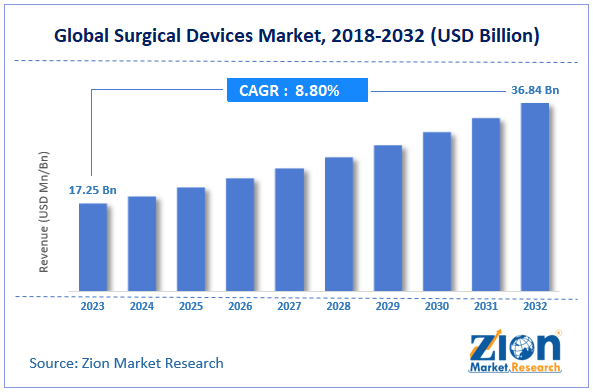Surgical Devices Market Size, Share, Growth, Trends, and Forecast 2032
The surgical devices market encompasses a broad range of instruments, tools, and technologies used in surgical procedures across various medical specialties. This market is driven by advancements in medical technology, the increasing prevalence of chronic diseases, a growing aging population, and a rising number of surgical procedures globally. The market includes traditional surgical instruments, minimally invasive devices, robotic surgery systems, and advanced technologies like laser and energy-based devices.

Get a Free Sample : https://www.zionmarketresearch.com/sample/surgical-devices-market
Key Market Insights
Market Growth Drivers:
- Increasing Surgical Procedures: The rise in the number of surgeries due to the growing prevalence of chronic diseases, trauma cases, and elective procedures is a significant driver of the market.
- Advancements in Technology: Innovations such as minimally invasive surgery (MIS), robotic-assisted surgery, and advanced imaging technologies are driving the demand for sophisticated surgical devices.
- Aging Population: The global increase in the aging population, who are more prone to conditions requiring surgical intervention, is boosting the market.
- Growing Healthcare Expenditure: Increasing investments in healthcare infrastructure, particularly in developing regions, are expanding access to surgical care and, consequently, the demand for surgical devices.
Market Segmentation:
- By Product Type:
- Handheld Devices: Scalpels, forceps, retractors, and scissors used in various surgical procedures.
- Electrosurgical Devices: Instruments used to cut tissue and control bleeding through electrical currents.
- Robotic Surgical Systems: Advanced robotic platforms that enhance precision and control in complex surgeries.
- Minimally Invasive Surgical Instruments: Devices designed for small incisions, including laparoscopes, endoscopes, and catheters.
- Laser and Energy-based Devices: Used for precise tissue cutting, ablation, and coagulation in surgeries.
- Others: Includes sutures, staplers, and wound closure devices.
- By Application:
- Orthopedic Surgery: Includes devices for joint replacements, spinal surgery, and fracture repair.
- Cardiovascular Surgery: Devices used in procedures like coronary artery bypass, heart valve repair, and angioplasty.
- Neurosurgery: Instruments and technologies for brain, spinal cord, and peripheral nerve surgeries.
- General Surgery: Includes devices for abdominal, thoracic, and other general procedures.
- Gynecology Surgery: Instruments used in procedures like hysterectomy, cesarean section, and laparoscopy.
- Ophthalmic Surgery: Devices for eye surgeries, including cataract and refractive surgery.
- ENT Surgery: Instruments for ear, nose, and throat procedures.
- Others: Includes urology, plastic surgery, and dermatology.
- By End-User:
- Hospitals: The largest end-user segment due to the high volume of surgeries performed in hospital settings.
- Ambulatory Surgical Centers (ASCs): Increasingly preferred for outpatient procedures due to lower costs and faster recovery times.
- Clinics: Used for minor surgical procedures and diagnostics.
- Others: Includes specialty centers and research institutes.
- By Product Type:
Geographical Insights:
- North America: The largest market due to advanced healthcare infrastructure, high healthcare expenditure, and a significant number of surgical procedures.
- Europe: A strong market driven by a well-established healthcare system, increasing demand for minimally invasive surgeries, and an aging population.
- Asia-Pacific: Expected to witness significant growth due to rising healthcare investments, expanding medical tourism, and improving healthcare infrastructure.
- Latin America and Middle East & Africa: Emerging markets with growing healthcare needs, increasing access to surgical care, and improving healthcare systems.
Challenges:
- High Costs: The high cost of advanced surgical devices, particularly robotic systems and minimally invasive instruments, can be a barrier to adoption in some regions.
- Regulatory Hurdles: Strict regulatory requirements and approval processes for surgical devices can delay market entry and increase costs.
- Shortage of Skilled Surgeons: The adoption of advanced surgical technologies like robotic systems requires specialized training, and a shortage of skilled surgeons can limit market growth in some areas.
- Infection Control: The need for strict infection control measures, especially in regions with limited resources, presents challenges in the use and maintenance of surgical devices.
Competitive Landscape:
- Key Players: Major companies in the market include Medtronic, Johnson & Johnson (Ethicon), Stryker Corporation, B. Braun Melsungen, and Intuitive Surgical. These companies focus on product innovation, strategic acquisitions, and expanding their product portfolios.
- Product Innovation: There is a strong emphasis on developing next-generation surgical devices that offer greater precision, reduced invasiveness, and improved patient outcomes.
Future Trends
- Robotic Surgery: The adoption of robotic-assisted surgery is expected to grow, offering enhanced precision, reduced recovery times, and better patient outcomes, particularly in complex procedures like urology, gynecology, and orthopedic surgeries.
- Minimally Invasive Surgery (MIS): The trend towards MIS will continue, driven by patient demand for faster recovery, less pain, and reduced hospital stays. Innovations in imaging and instrument design will support this growth.
- Artificial Intelligence (AI) and Machine Learning: AI and machine learning will increasingly be integrated into surgical devices, offering improved decision support, real-time analytics, and enhanced precision during surgeries.
- 3D Printing: The use of 3D printing in surgical device manufacturing is expected to grow, particularly for creating patient-specific implants and instruments, which can improve surgical outcomes.
- Sustainability and Reusability: The market may see a shift towards more sustainable and reusable surgical devices, driven by environmental concerns and the need to reduce healthcare waste.
The surgical devices market is poised for continued growth as technological advancements, an aging population, and increasing healthcare expenditure drive demand for innovative and effective surgical tools. The future will likely see a greater focus on minimally invasive techniques, robotic surgery, and the integration of AI, leading to improved patient outcomes and more efficient surgical procedures.
Contact :
US OFFICE NO +1 (302) 444-0166
US/CAN TOLL FREE +1 (855) 465-4651
Email: sales@zionmarketresearch.com

Comments
Post a Comment